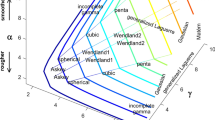Abstract
Empirical Orthogonal Function (EOF) analysis of spatial random fields involves calculation of the eigenfunctions of the covariance kernel of the field. For real-world applications, a numerical approximation is necessary because the process is spatially discretized. An approximation for two-dimensional fields is proposed and then, analytical solutions of the integral problem are derived and used to study the accuracy of the numerical approximations. Sampling effects are also considered.
Similar content being viewed by others
References
Bouhaddou, O. 1984: Analyse en composantes principales et interpolation de processus. Méthode et simulation. Thèse de 3ème cycle, UJF, Grenoble, 165 pp.
Bouhaddou, O.; Obled, Ch.; Pham Dinh Tuan, A. 1987: Principal component analysis and interpolation of stochastic processes. Methods and simulation. Journal of Applied Statistics 14 (3), 251–267
Braud, I. 1990: Etude méthodologique de l'Analyse en Composantes Principales de processus bidimensionnels. Effets des approximations numériques et de l'échantillonnage et utilisation pour la génération de champs aléatoires. Application au traitement des températures de surface de la mer sur l'Atlantique intertropical. Doctorat INPG, Grenoble, 214 pp.
Braud, I; Obled, Ch. 1989: A comparison between analytical eigenfunctions of a covariance kernel and their numerical approximations. Preprints of the 11th Conference on Probability and Statistics in Atmospheric Sciences. October 1–5 1989, Monterey (Ca). American Meteorological Society, 26–29
Braud, I.; Obled, Ch. 1991: On the use of Empirical Orthogonal Function (EOF) analysis in the simulation of random fields. Stochastic Hydrology and Hydraulics 5, 125–134
Buell, E.C. 1975: The topography of the empirical orthogonal functions. Preprints of the 4th Conference on Probability and Statistics in Atmospheric Sciences. November 18–21, 1975 Tallahasse [Florida). American Meteorological Society, 188–193
Buell, E.C. 1979: On the physical interpretation of empirical orthogonal functions. Preprints of the 6th Conference on Probability and Statistics in Atmospheric Sciences. Banff. American Meteorological Society, 112–117
Déqué, M. 1986: On the comparison between two sets of 500 mb geopotential height eigenfunctions. Tellus 38A, 448–452
Deville, J.C. 1974: Méthodes statistiques et numériques de l'analyse harmonique. Annales de I'INSEE 15, 1–101
Fortus, M.I. 1975: Statistically orthogonal functions for a random field specified in a finite region of the plane. Izvestia Academic Sciences USSR. Atmospheric Oceanic Physics 11(11), 1107–1112
Holmström, I. 1963: On a method for parametric representation of the state of the atmosphere. Tellus 15(2), 127–149
Holmström, I. 1977: Optimization of atmospheric models. Tellus 29(5), 415–427
Mac Veigh, J. P.; Barnier, B.; Le Provost, C. 1987: Spectral and EOF analysis of four years of ECMWF wind stress curl over the North Atlantic Ocean. Journal of Geophysical Research 92, 13–141, 13–152
Mantoglou, A.; Wilson, J. L. 1982: The turning band method for simulation of random fields using line generation by a spectral method. Water Resources Research 18(5), 1379–1394
Matheron, G. 1973: The intrinsic random functions and their applications. Advanced Applied Probability 5, 439–468
North, G. R.; Bell, T. L.; Cahalan, R. F.; Moeng, F. J. 1982: Sampling errors in the estimation of Empirical Orthogonal Functions. Monthly Weather Review 110, 699–706
Obled, Ch.; Braud, I. 1989: Analogies entre géostatistique et analyse en composantes principales de processus ou analyse EOFs. Geostatistics 1, M. Armstrong Ed., Kluwer Academic Publishers, Dordrecht, Boston, London, 237–248
Obled, Ch.; Creutin, J. D. 1986: Some developments in the use of Empirical Orthogonal Functions for mapping meteorological fields. Journal of Applied Meteorology 25(9), 1189–1204
Rao, A. R.; Hsieh, C. H. 1991: Estimation of runoff at ungauged locations by Empirical Orthogonal Functions. Journal of Hydrology 123, 51–67
Richman, M. B. 1986: Review article: rotation of Principal Component Analysis. Journal of Climatology 6, 293–335
Servain, J.; Legler, S. 1986: Empirical orthogonal function analysis of tropical atlantic sea surface temperature and wind stress: 1964–1979. Journal of Geophysical Research 91(C12), 14–181, 14–191
Author information
Authors and Affiliations
Rights and permissions
About this article
Cite this article
Braud, I., Obled, C. & Phamdinhtuan, A. Empirical Orthogonal Function (EOF) analysis of spatial random fields: Theory, accuracy of the numerical approximations and sampling effects. Stochastic Hydrol Hydraul 7, 146–160 (1993). https://doi.org/10.1007/BF01581422
Issue Date:
DOI: https://doi.org/10.1007/BF01581422




